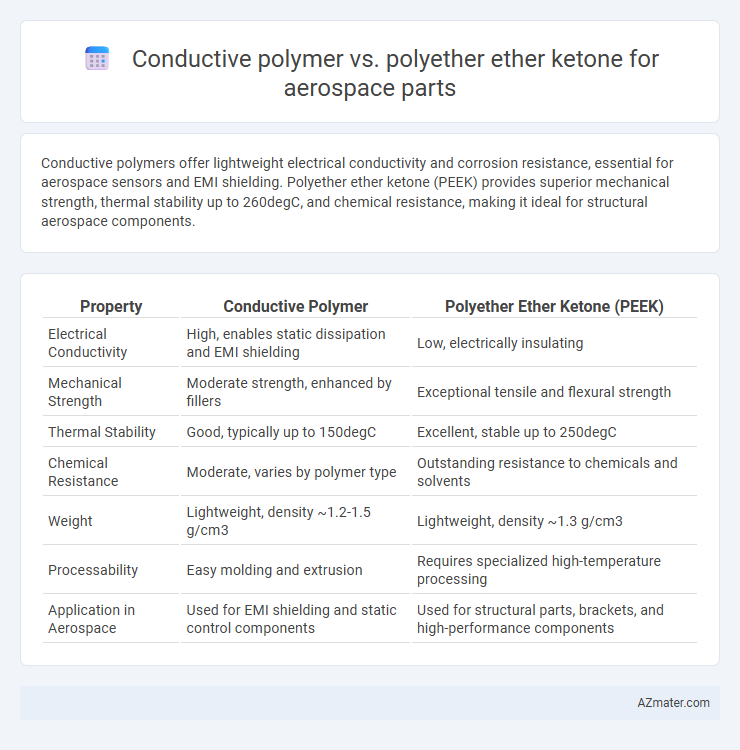Conductive polymers offer lightweight electrical conductivity and corrosion resistance, essential for aerospace sensors and EMI shielding. Polyether ether ketone (PEEK) provides superior mechanical strength, thermal stability up to 260degC, and chemical resistance, making it ideal for structural aerospace components.
Table of Comparison
| Property | Conductive Polymer | Polyether Ether Ketone (PEEK) |
|---|---|---|
| Electrical Conductivity | High, enables static dissipation and EMI shielding | Low, electrically insulating |
| Mechanical Strength | Moderate strength, enhanced by fillers | Exceptional tensile and flexural strength |
| Thermal Stability | Good, typically up to 150degC | Excellent, stable up to 250degC |
| Chemical Resistance | Moderate, varies by polymer type | Outstanding resistance to chemicals and solvents |
| Weight | Lightweight, density ~1.2-1.5 g/cm3 | Lightweight, density ~1.3 g/cm3 |
| Processability | Easy molding and extrusion | Requires specialized high-temperature processing |
| Application in Aerospace | Used for EMI shielding and static control components | Used for structural parts, brackets, and high-performance components |
Introduction to Aerospace Material Innovation
Conductive polymers offer lightweight, corrosion-resistant properties and electrical conductivity crucial for aerospace applications, while polyether ether ketone (PEEK) provides exceptional thermal stability, mechanical strength, and chemical resistance. Innovations in aerospace materials prioritize combining these polymers to enhance electromagnetic interference shielding and structural integrity in high-performance components. The ongoing development of composite materials integrating conductive polymers and PEEK advances aerospace part reliability, weight reduction, and multifunctionality.
Overview of Conductive Polymers
Conductive polymers, such as polyaniline and polypyrrole, offer lightweight and electrically conductive properties ideal for aerospace applications requiring EMI shielding and lightning strike protection. These polymers provide excellent corrosion resistance and can be tailored for specific conductivity levels, making them suitable for multifunctional aerospace components. Polyether ether ketone (PEEK), while mechanically robust and thermally stable, lacks inherent conductivity and is primarily valued for structural applications without electrical functionality.
Understanding Polyether Ether Ketone (PEEK)
Polyether ether ketone (PEEK) is a high-performance thermoplastic widely used in aerospace due to its exceptional mechanical strength, chemical resistance, and thermal stability up to 260degC. Compared to conductive polymers, PEEK offers superior dimensional stability and resistance to harsh environmental conditions, making it ideal for critical structural aerospace parts. Its low flammability and excellent dielectric properties enhance safety and reliability in demanding aerospace applications.
Mechanical Properties Comparison
Conductive polymers typically offer moderate mechanical strength with flexibility and impact resistance, making them suitable for lightweight aerospace components requiring electrical conductivity. Polyether ether ketone (PEEK) exhibits superior tensile strength, high stiffness, and excellent thermal stability, providing durability under extreme aerospace conditions. Compared to conductive polymers, PEEK's mechanical properties such as tensile modulus (3.6 GPa) and tensile strength (90-100 MPa) are significantly higher, ensuring enhanced structural integrity in demanding aerospace applications.
Thermal Stability and Heat Resistance
Conductive polymers offer moderate thermal stability with decomposition temperatures typically below 300degC, making them suitable for applications requiring electrical conductivity but limited heat resistance. Polyether ether ketone (PEEK) exhibits exceptional thermal stability and heat resistance, maintaining structural integrity and mechanical performance at continuous use temperatures up to 250degC and short-term exposure beyond 300degC. PEEK's superior thermal properties and resistance to thermal degradation make it a preferred choice in aerospace components subjected to extreme thermal cycling and high-temperature environments.
Electrical Conductivity Differences
Conductive polymers exhibit electrical conductivity ranging from 10^-6 to 10^3 S/m due to their conjugated backbone structure, making them suitable for electromagnetic interference shielding and static dissipation in aerospace applications. Polyether ether ketone (PEEK), a high-performance thermoplastic, has an inherently low electrical conductivity (~10^-15 S/m), functioning primarily as an electrical insulator but offering excellent thermal stability and mechanical strength. The significant disparity in electrical conductivity between conductive polymers and PEEK dictates their specific roles in aerospace parts, where conductive polymers are chosen for electrical functionality while PEEK is selected for insulating properties and structural performance.
Weight and Density Considerations
Conductive polymers weigh significantly less than Polyether ether ketone (PEEK), offering densities typically around 1.2 g/cm3 compared to PEEK's density of approximately 1.3 g/cm3, which is critical for aerospace applications demanding lightweight components. Lower density in conductive polymers contributes to enhanced fuel efficiency and payload capacity by reducing overall structural weight. Selecting conductive polymers over PEEK supports aerospace design goals centered on minimizing weight while maintaining functional performance.
Chemical Resistance and Durability
Conductive polymers exhibit moderate chemical resistance suited for aerospace environments with exposure to solvents and fuels, while Polyether ether ketone (PEEK) offers superior chemical resistance against acids, bases, and hydrocarbon solvents, ensuring long-term stability. PEEK demonstrates exceptional durability under high thermal stress and mechanical loads typical in aerospace applications, outperforming many conductive polymers in maintaining structural integrity. The inherent resistance of PEEK to harsh chemicals and its ability to retain mechanical properties at elevated temperatures make it a preferred choice for critical aerospace components requiring both chemical resilience and longevity.
Aerospace Application Case Studies
Conductive polymers demonstrate superior electromagnetic interference (EMI) shielding and lightning strike protection in aerospace components, enhancing aircraft safety and system reliability. Polyether ether ketone (PEEK) offers exceptional thermal stability, chemical resistance, and mechanical strength, making it ideal for structural aerospace parts exposed to extreme environments. Case studies highlight conductive polymers in radar-absorbing panels and sensor housings, while PEEK is extensively used in jet engine components and lightweight airframe parts, underscoring their complementary roles in aerospace applications.
Future Trends and Material Selection Guidance
Conductive polymers are gaining traction in aerospace applications due to their lightweight properties, electrical conductivity, and potential for electromagnetic interference (EMI) shielding, making them ideal for next-generation avionics and sensor integration. Polyether ether ketone (PEEK) remains a preferred choice for structural aerospace parts because of its exceptional thermal stability, mechanical strength, and chemical resistance under extreme environmental conditions. Future trends indicate a growing emphasis on hybrid material systems combining conductive polymers with PEEK to optimize performance, reduce weight, and enhance multifunctional capabilities in aerospace component design.

Infographic: Conductive polymer vs Polyether ether ketone for Aerospace part
 azmater.com
azmater.com